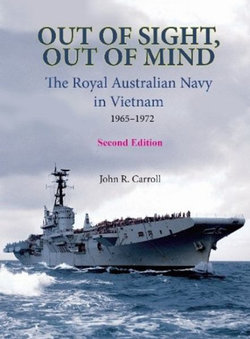
Out of Sight, Out of Mind; The Royal Australian Navy in Vietnam 1965-1972 (Second Edition). By John R Carroll. Rosenberg Publishing, Dural 2019.
Reviewed by Tim Coyle
The war in Vietnam is known as the ‘television war’ as nightly news telecasts carried graphic footage of combat operations by Australian and US troops for years in the 1960s and early 1970s. This exhaustive coverage fed community disquiet leading to mass ‘moratorium’ demonstrations by students and other community members while increasing numbers of Australian troops died in action or were returned wounded to Australia. What was not foreseen at the time of Australian withdrawal from the war in 1971 was the effect of what is now known as Post Traumatic Stress Disorder on veterans and the creeping cancers inflicted by Agent Orange defoliant.
Out of Sight, Out of Mind is devoted to the RAN ships and their companies engaged in logistic support to the Australian Army Task Forces in Vietnam. These comprised the former aircraft carrier HMAS Sydney, converted to a troop and logistic transport, and two Australian National Line merchant ships Boonaroo and Jeparit, the latter two commissioned as HMA Ships following refusal of Seamen’s Union members to man them, and the RAN destroyers and frigates which served as escorts for the transport voyages.
The author, John Carroll, served in HMAS Sydney as a shipwright and this book is based on his doctoral dissertation. Consequently, this is a book of record with extensive interviews with naval veterans and an exhaustive bibliography of primary and secondary sources.
Essentially Carroll defends the record of the RAN logistics effort to Vietnam, pointing out the perceived paucity of credit given to this essential operation without which Australia could not deploy or sustain the army task force for the seven years of engagement in the field.
After highlighting the lack of mention in other histories of the RAN’s support, Carroll provides a comprehensive treatise on Australia’s almost contemporaneous involvement in the ‘konfrontasi’ with Indonesia over Malaysia in the early years of Vietnam and discusses Australia’s forward defence policies. This is a creditable narrative of how Australia came to be involved in Vietnam. Carroll then discusses the arrangements and operational aspects of the 25 return voyages undertaken by HMAS Sydney, and escorting warships, and activities in the war zone discharging and loading troops and equipment.
Carroll emphasises the wartime conditions in which Sydney and escorts operated. Intelligence assessed possible subsurface and surface threats from Indonesian, Chinese or Russian forces and so escorts maintained anti-submarine and surface threat readiness en-route and Sydney itself undertook force protection measures at anchor in Vietnam.
The incidences of cancer, especially prostate cancer, among RAN members and the scientific evidence that this was attributed to their consumption of fresh water distilled from estuarine waters of Vietnam is covered in a chapter on herbicide exposure. This highly detailed chapter also discusses the long-running disputes between veterans, scientists and the Australian Government regarding Agent Orange use in Vietnam.
The human side of service in HMAS Sydney is illustrated in the chapter In Their Own Words in which veterans describe the austere habitability conditions on the ship. Sydney was a British ship built at the end of World War 2 with little thought to operations in the tropics and the severe and continuous discomfort experienced by all on board is candidly told.
Out of Sight Out of Mind concludes with discussion of the long struggle veterans endured to secure some recognition for their service. While the ships’ companies of the RAN Charles F Adams class guided missile destroyers deservedly received veterans’ benefits for their service providing naval gunfire support this was not the case for Sydney and escorts. The Government considered they were not engaged in war service despite their essential support to the Australian Army Task Force and the assessed threat on passage and when anchored in Vietnamese waters.
The book is illustrated with many photographs of the ships and on-board activity together with maps and an extensive appendix detailing the various ships’ characteristics.In summary this book provides a balanced and important contribution to the historiography of Australian participation in the Vietnam war, particularly by detailing the hardships and dangers faced by the ships’ companies engaged in logistic support to the Australian Army Task Force




Great work John, enjoyed the book